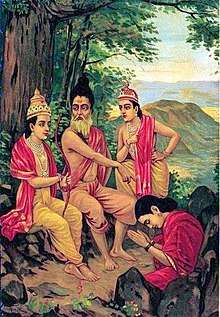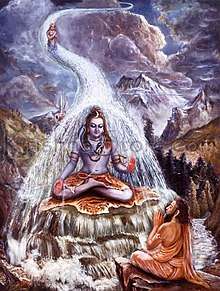Gautama Maharishi
Gautama Maharishi (Sanskrit: महर्षिः गौतम Maharṣiḥ Gautama) was a Rigvedic sage in Hinduism, and also finds mentions in Jainism and Buddhism.[1] According to Vamana Purana with, he had three daughters named Jaya, Jayanti and Aparajita.[2] According to Valmiki Ramayan, the eldest son is Satananda, and according to Adi Parva, he had two sons named Saradvan and Cirakari. Saradvan was also known as Gautama, hence his son Kripa and Kripi were called Gautama and Gautami respectively. Beside this Gautama has daughter named Anjana who is the mother of Lord Hanuman .[3] maharshi after making one place fertile used to shift to the next place. Like this many maharshis bless the place with their Tapas and move on. The aashramams used by such Divya-rushis later become Siddha-aashramams.
Maharishi Gautama | |
|---|---|
 An Early 19th Century Painting Showing Maharishi Gautama | |
| Personal | |
| Religion | Hinduism |
| Spouse | Ahalya |
| Children | Shatananda (son), Nodhas (son), Anjana (daughter), Vamadeva (son) |
| Parents | Dirghatamas (father), Pradweshi (mother) |
| Lineage | Maharishi Angiras (mind-born son of brahma) |
| Relatives | Bhardwaja (uncle) |
| Honors | one of the Saptarishis (Seven Great Sages Rishi),Founder of Nyaya Shastra,Dharam Sutra |
| Part of a series on | ||||||||||||||||||||||||||||
| Hindu philosophy | ||||||||||||||||||||||||||||
|---|---|---|---|---|---|---|---|---|---|---|---|---|---|---|---|---|---|---|---|---|---|---|---|---|---|---|---|---|
 | ||||||||||||||||||||||||||||
| Orthodox | ||||||||||||||||||||||||||||
|
|
||||||||||||||||||||||||||||
| Heterodox | ||||||||||||||||||||||||||||
|
|
||||||||||||||||||||||||||||
|
Teachers (Acharyas)
|
||||||||||||||||||||||||||||
|
|
||||||||||||||||||||||||||||
Rig-Veda
The Rig Veda has several suktas (Sanskrit: 'hymns') that mentions him. The Vedic sage Gautama is credited with authoring many hymns in Mandala 1.[4]
He was the son of Dirghatamas, belonging to the lineage of Angirasa. Gautama was the progenitor of the paternal Gautama gotra lineage. Gautama and Bharadvaja share a common ancestry, as they are both descended from Angirasa, and sometimes they are both bracketed together under the name Angirasa.
Epics and Puranic Mythologies
The Devi Bhagavatam says that the river Godavari is so named because of its association with Gautama. He had two sons by name Vamadeva and Nodhas, both themselves discoverers of Mantras. There is a hymn called Bhadra in the Sama Veda which again is ascribed to Gautama Maharishi. The descendant of Lord Shiva as Trimbakeshvar, that constitutes the source of the Jyotirlinga nearby, happened for the sake of Gautama. The Brahmanda Purana mentions that one of the sub-branches of the Raanaayani branch of Sama Veda was initiated by this Gautama. Some famous disciples of Gautama were Satyakama jabala Praachina-yogya, Shaandilya, Gārgya, and Bharadvaja.
Curse given to Indra and Ahalya – Rāmāyaṇa

The Bala Kanda mentions that Gautama spots Indra, who is still in disguise, and curses him to lose his testicles. Gautama then curses Ahalya to remain invisible to all beings for thousands of years, fast by subsisting only on air, suffer and sleep in ashes and be tormented by guilt. Nevertheless, he assures her that her sin will be expiated once she extends her hospitality to Rama, who will visit the ashram. Thereafter, Gautama abandons the ashram and goes to the Himalayas to practise asceticism. The Ayodhya prince Rama, his brother Lakshmana and their guru, the sage Vishvamitra pass Gautama's desolate ashram while travelling to King Janaka's court in Mithila. As they near the ashram, Vishvamitra recounts the tale of Ahalya's curse and instructs Rama to save Ahalya. Although Ahalya is cursed, Vishvamitra nevertheless describes her as goddess-like and illustrious, repeatedly calling her mahabhaga, a Sanskrit compound (maha and bhaga) translated as "most illustrious and highly distinguished"; this interpretation contrasts with that of Rambhadracharya, who believes that the word mahabhaga, in the context of Ahalya's story, means "extremely unfortunate" (maha and abhaga). Following Vishvamitra, the princes enter the ashram to see Ahalya, who, up till then, had been hidden from the universe. Ahalya is described as glowing from the intensity of her ascetic devotion, but hidden from the world like the Sun obscured by dark clouds, the light of a full moon hidden by mist or a blazing flame masked by smoke. Under the direction of his guru, Rama considers Ahalya pure and unblemished and, accompanied by Lakshamana, gives her obeisance by touching her feet, an act that restores her social status. She greets them, recalling Gautama's words that Rama would be her redeemer. Ahalya extends her warmest reception, making a "welcome offering" of forest fruits and washing their feet, an act of respect according to the rites of that era. The gods and other celestial beings shower Rama and Ahalya with flowers and bow to Ahalya, who has been purified through her penance. Gautama then returns to his ashram and accepts her.
Story of Triyambkeshwar Jyotrilinga

Brahmadev worshipped God Trivikram when he came to Satya Loka (on earth) with the same holy water of the Ganges, to get the river Ganges held up by God Shankar on his head, to flow. There was a famine of 24 years and people were affected by the pangs of hunger. However, Varun – the God of Rains, pleased with Sage Gautama arranged rains every day in Gautama's Ashram (dwelling place) which was in Trimbakeshwar. Gautama used to sow rice in the surrounding fields of his Ashram in the morning, reap the crop in the afternoon and with it fed a large group of Hrishis, who took shelter in his Ashram on account of the famine. The blessings of the group of rishis increased the merit (Punya) of Gautama. Lord Indra's position became shaky because of his increased merit. So Indra ordered clouds to rain all over Trimbakeshwar, so that the famine will be over and rishis will go back and the increasing merits of Gautama will be weakened. Although the famine was over, Gautama urged the Rishis to stay back and kept on feeding them and gaining merit. Once he saw a cow grazing in the paddy field and he drove her away by throwing Darbha (sharp, pointed grass). The slender cow died by this. It was Jaya – Parvati's friend, who had taken the form of a cow. This news upset the Rishis and they refused to luncheon at his Ashram. Gautama requested Rishis to show a way out of this sin. He was advised to approach Lord Shiva and request him to release the Ganges and a bath in the Ganges would set him free of his sins. Gautama then practiced penance by going to the peak of Brahmagiri for 1000 years. Lord Shankara was pleased by his worships and gave him the Ganga. However, Ganges was not prepared to part with Lord Shiv, which irritated him. He made TandavNrutya (dance) on the peak of Brahmagiri and dashed his jata there. Frightened by this action, Ganges appeared on Brahmagiri. Later on, Ganges appeared in the Trimbak Tirtha. Gautama praised her but she off and on appeared on the mountain at various places and disappeared in anger. Gautama could not bathe in her waters. The Ganges then appeared in Gangadwar, Varaha-tirtha, Rama-Laxman tirtha, Ganga Sagar tirtha. Still, Gautama could not bathe in her waters. The Gautama surrounded the river with enchanted grass and put a vow to her. The flow stopped there and the tirtha thus came to be called Kushavarta. It is from this Kushavarta that the river Godavari flows up to the sea. The sin of killing a cow by Gautama was wiped off here.
References
- Inhabitants of the Worlds Mahanirvana Tantra, translated by Arthur Avalon, (Sir John Woodroffe), 1913, Introduction and Preface. The Ṛṣis are seers who know, and by their knowledge are the makers of shastra and "see" all mantras. The word comes from the root rish Rishati-prāpnoti sarvaṃ mantraṃ jñānena paśyati saṃsaraparaṃva, etc. The seven great Ṛṣis or Saptarṣis of the first manvantara are Marichi, Atri, Angiras, Pulaha, Kratu, Pulastya, and Vashishtha. In other manvantara there are other sapta-rshi. In the present manvantara the seven are Kashyapa, Atri, Vashishtha, Vishvamitra, Gotama, Jamadagni, Bharadvaja. Gautama was married to Ahalya.To the Ṛṣis the Vedas were revealed. Vyasa taught the Rigveda so revealed to Paila, the Yajurveda to Vaishampayana, the Samaveda to Jaimini, Atharvaveda to Samantu, and Itihasa and Purana to Suta. The three chief classes of Ṛṣis are the Brahmarshi, born of the mind of Brahma, the Devarshi of lower rank, and Rajarshi or Kings who became Ṛṣis through their knowledge and austerities, such as Janaka, Ritaparna, etc. Thc Shrutarshi are makers of Shastras, as Suśruta. The Kandarshi are of the Karmakanda, such as Jaimini.
- "Puranic encyclopaedia : a dictionary with special reference to epic and Puranic literature". archive.org. 1975.
- "Puranic encyclopaedia: a dictonary with special reference to the epic and Puranic literature". archive.org. 1975.
- Stephanie Jamison; Joel Brereton (2014). The Rigveda: 3-Volume Set. Oxford University Press. p. 1186. ISBN 978-0-19-937018-4.